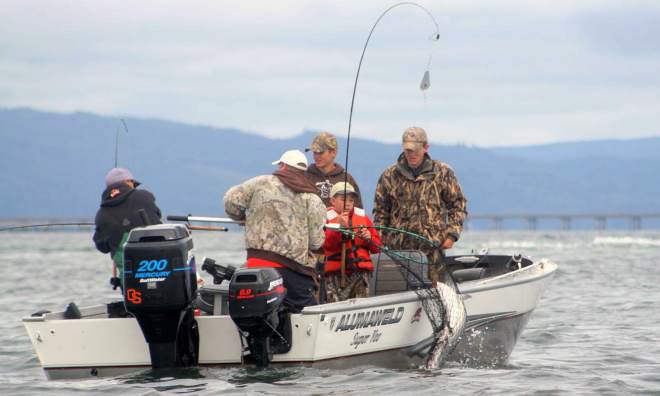forum
library
tutorial
contact

Fall Chinook Run Best Ever
on Columbia River
by Jeff Barnard, Associated Press
Yakima Herald, September 15, 2013
|
the film forum library tutorial contact |

|
Fall Chinook Run Best Ever
by Jeff Barnard, Associated Press
|
 The fall Chinook salmon run on the Columbia River is the largest ever, and could hit 1 million fish by the time it is done.
The fall Chinook salmon run on the Columbia River is the largest ever, and could hit 1 million fish by the time it is done.
The fish count at Bonneville Dam went over 613,700 on Friday, the largest number since the dam was completed in 1938.
At the peak of the run, nearly 64,000 fish passed the viewing windows in a single day.
The unprecedented abundance has prompted fisheries manager to extend sport, commercial and tribal fishing seasons on the river, and expand daily bag limits.
Biologists say it is the result of a perfect combination of abundant food and cool temperatures in the ocean, court-ordered actions over the past decade to make the 14 dams in the Columbia Basin less lethal to fish and improvements at fish hatcheries -- particularly those run by the Nez Perce Tribe in Idaho.
Pacific State marine Fisheries Commission biologist Joe Hymer said the total could hit 1 million by the end of December, when the fall Chinook run is officially completed.
"We're just post-peak and the counts are still strong," he said. "It's in the realm of possibility."
The 10-year average is 243,207 fish at Bonneville.
While the number of fish is the most since Bonneville Dam was completed, conditions were far different in the early days of the dam. There were no other major dams upstream, all of which kill a small percentage of young fish migrating to the ocean, said Gilly Lyons of Save Our Wild Salmon, a conservation group.
And there were no restrictions on fishing, which took a much higher percentage of the run, said NOAA Fisheries Service spokesman Brian Gorman.
While fishing seasons and bag limits have been extended, they will remain constrained by fears that other stocks of less abundant fish could be hurt by too much catching, said Hymer.
NOAA Fisheries Service biologist Bill Peterson said fall Chinook have enjoyed favorable ocean conditions for the past few years, with lots of high fat content zooplankton to eat, and cool water temperatures in the waters off Oregon and Northern California, where they grow from juveniles to adults before returning to their home rivers to spawn. Though an ocean-warming El Nino was forecast for late last year, it never really materialized. And the climatic condition known as the Pacific Decadal Oscillation, which is related to El Nino, has also been favorable.
"We predicted it was going to be good, but this is better than good," Peterson said. "Things will be great next year, too."
Peterson noted that predictions of abundant spring chinook returns did not pan out. Those fish found less favorable conditions in the Gulf of Alaska, where they grow up. Neither did predictions for coho salmon.
Gilly Lyons of the conservation group Save Our Wild Salmon said court-ordered changes to dam operations were a major factor as well. Lawsuits have forced the U.S. Army Corps of Engineers to spill some water over the dams rather than running it all through turbines to produce power. That results in a higher rate of survival for the young fish, helping produce larger returns of adults.
The government has also done billions of dollars' worth of modifications to the dams to make them less lethal to fish, and to improve river habitat.
While the majority of fish returning to the Columbia are produced by hatcheries, the numbers of naturally spawning fish is rising.
The Nez Perce Tribe hatchery in Idaho, among others, has been using wild fish for broodstock to improve genetics, and release young fish throughout the watershed to acclimate them so they will return to a wide area to spawn, rather than just swimming back to the hatchery, said Sara Thompson of the Columbia River Inter-Tribal Fish Commission.
"Everyone is able to fish when we have these returns," she said. "That's the exciting thing. That's what we need to be working toward."
learn more on topics covered in the film
see the video
read the script
learn the songs
discussion forum
